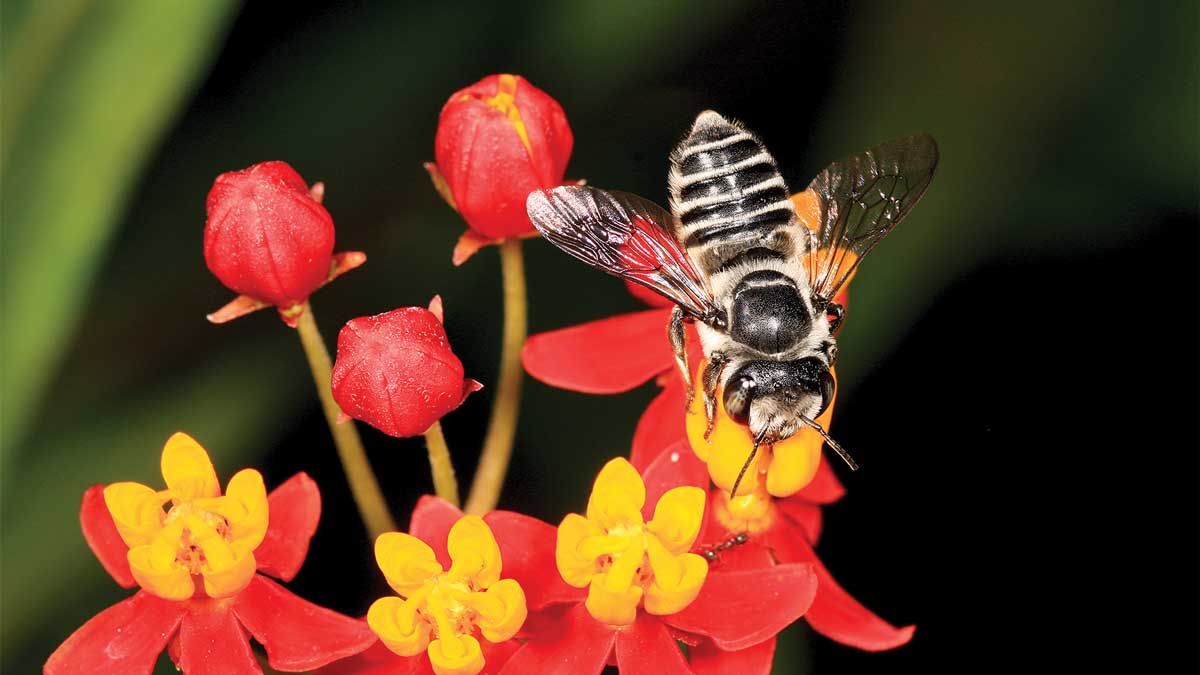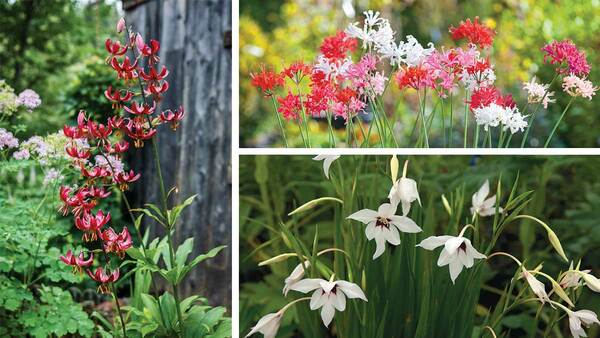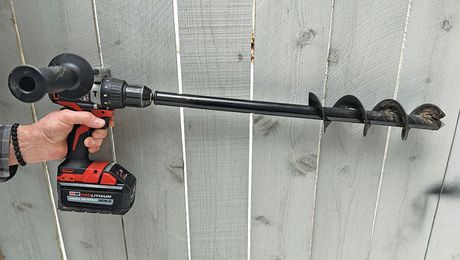
Containers filled with pollinator-pleasing plants will bring an assortment of fascinating creatures to your yard. From the portfolio of nature photographer Bill Johnson, let’s take a look at some of the pollinator types you are most likely to see. Learn how you can garden for pollinators, whether you have a large garden or small.
Domesticated honeybees
Honeybees (photo above) are the familiar foragers often found near agricultural areas and hobbyists’ hives; colonies occasionally escape into the wild.
- ID tips: Honeybees have fuzzy, oval-shaped bodies with a less narrow “waist” between the thorax and the abdomen than wasps and most other bees have.
- Notable species: European honeybee
- Favorite flower types: Shallow or tubular shapes, preferably with a landing area, in bright white, blue, or yellow

Wild bees
Wild bees are very diverse, with nearly 4,000 North American native species. Almost all are solitary rather than social nesters.
- ID tips: Bees typically have fuzzy bodies that range from metallic green or blue to brown or black, sometimes striped with yellow, white, or red.
- Notable species: Bumblebees, orchard bees, carpenter bees, sweat bees, mason bees, and leafcutter bees (pictured)
- Favorite flower types: Shallow or tubular shapes, preferably with a landing area, that are blue, purple, white, orange, or yellow

Wasps
You might be surprised to learn that visit wasps are also pollinators! They often visit flowers mainly in search of nectar and insect prey; however, they can sometimes be very effective pollinators.
- ID tips: Wasps are typically smooth, not fuzzy, with a pointed lower abdomen and a narrow waist between the abdomen and the thorax.
- Notable species: There are about 18,000 North American species, including paper wasps, yellow jackets, mud daubers (pictured), thread-waisted wasps, and tiny Trichogrammas.
- Favorite flower types: Shallow, nectar-rich flowers, often with dull colors or unusual scents

Butterflies
Butterflies have long legs and tongues that keep them from picking up as much pollen as bees, but they can be surprisingly efficient pollinators.
- ID tips: Most butterflies land and rest with their wings folded together vertically over their bodies, while moths tend to rest with their wings open and flat.
- Notable species: There are several hundred North American species, including skippers, blues, swallowtails (pictured), hairstreaks, sulphurs, and brush-footed species.
- Favorite flower types: Bright red or purple with deep, tubular shapes, abundant nectar, and wide landing pads

Moths
Moths are underappreciated pollinators, since many feed only at night. However, some moths fly by day, such as the snowberry clearwing (pictured).
- ID tips: Nearly all moths rest with their wings open and flat, while butterflies tend to hold theirs upright.
- Notable species: There are about 20,000 North American moth species, including hawk moths, sphinx moths, tussock moths, daggers, and luna moths.
- Favorite flower types: White, pink, purple, or pale red; sweetly fragrant, with ample, deeply hidden nectar

Flies
Flies are another extremely large, varied, and underappreciated pollinator group. Some species have markings similar to those of bees or wasps that deter predators.
- ID tips: Flies have two wings instead of four, and most have extremely large eyes that come together at the top of the head.
- Notable species: Hoverflies, robber flies, bee flies (pictured), flower flies, syrphid flies, and tachnids
- Favorite flower types: Shallow or funnel-like shapes that are pale, dark brown, or purple, sometimes with a putrid odor

Hummingbirds
Hummingbirds are always on the move. Each bird drinks up to twice its weight in nectar each day, transporting pollen between plants as it feeds.
- ID tips: Hummingbirds are easily identified by their small size, long, tapered beaks, and ability to hover in flight.
- Notable species: There are only a handful of North American species, including ruby-throated, broad-tailed, rufous, Anna’s, Costa’s, and black-chinned hummingbirds.
- Favorite flower types: Colorful, tubular flowers with abundant nectar

Beetles
Beetles are one of the oldest pollinator groups on earth. Some chew through flower petals, leaving waste behind, and are called “mess and soil” pollinators.
- ID tips: Beetles have hard wing coverings that are folded back in flight and sharp mandibles on the underside of the head.
- Notable species: Soldier beetles, scarabs, long-horned beetles, checkered beetles, sap beetles, and lady beetles (pictured)
- Favorite flower types: Large, bowl-shaped blooms with ample pollen and strong scents that are sweet, musky, spicy, fruity, or putrid
Sarah Partyka is the owner of The Farmer’s Daughter, a garden center in South Kingstown, Rhode Island.






















Comments
Bees. Certain flowers attract pests like bees, like marigolds and coneflowers, so you may want to plant some close to your vegetable garden. ...
Hummingbirds. Photo: ondrejprosicky / Adobe Stock. ...
hız testi
Log in or create an account to post a comment.
Sign up Log in